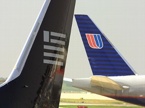
Subscribers can access this week’s issue of PlaneBusiness Banter here.
Monthly Archives: May 2008
BOTBS Version 2.0: Getting Closer to the “Buy the Survivor” Call Airline Industry Investors Are Waiting For

It’s Friday, and that means yours truly is working on this week’s issue of Plane Business Banter. Actually for the last hour or so I’ve been going through the latest effort by Jamie Baker and Mark Streeter, analysts at JP Morgan. Yesterday the duo put out what they call v2.0 of their BOTBS.
Got that?
BOTBS stands for Battle of the Balance Sheets.
Yesterday the dynamic duo updated the first version of the BOTBS they put out last week — and I’m going to be taking an updated look at some of their comments in this week’s issue of PBB. The whole point of the exercise is to take a comprehensive view of the potential severity of the cash burn rates from airline operations, as well as identify capital raising options for those same airlines.
Last week’s version was probably most noteworthy for the pair’s “ranking” of what it considered to be each airline’s bankruptcy risk.
As Jamie and Mark said in the report,
“Last week’s Battle Of The Balance Sheets report generated welcome feedback from managements and investors alike. Managements, for the most part, felt our revenue inputs were too draconian. We hope that turns out to be the case, though would still argue on behalf of our methodology. We’ve generously given the industry only half- credit for a potential U.S. recession. Demand trends consistently reverse 10 – 15% during recessions, whereas we assume a gentler 5 – 6% reversion this time. And some managements (as well as investors) felt we did our liquidity analysis a disservice by not incorporating abundant capital raising progress. But of course, that was by design. Our report is deliberately intended to highlight where needs are greatest, as well as broadly identify the capital steps managements are likely to seek in hopes of bolstering rapidly declining cash balances. We readily concede that the liquidity projections in this report will likely never come to fruition – one can’t actually run an airline with a negative cash balance. But timing of cash flows is paramount in this war of attrition, where managements appear fixated on outliving one another rather than taking the requisite steps to generate acceptable returns. We continue, for example, to expect a flurry of press releases announcing European aircraft bank deals that raise cash against currently-or-soon-to-be unencumbered aircraft…and/or pre-delivery deposit facilities that free up cash being held by manufacturers…and/or convertible issues…and/or frequent flier mileage forward sales…and/or sale-leasebacks, vendor lifelines, non-core asset sales and the like. As these efforts play out, it will hopefully bring us closer to making the “buy the survivors” type call that investors increasingly appear to be clamoring for, now that the magnitude of projected losses is finally beginning to settle in.”
Were there any changes to the pair’s “bankruptcy rankings” in this version?
Yes.
Southwest, Alaska, Delta, and AirTran remain at the top of the list as those airlines having the least amount of Chapter 11 risk.
But after that, we had some moving around.
With the announcement of its debt offering, JetBlue moved up into fifth spot, behind AirTran, while Continental got knocked down to sixth place.
American moved up to seventh, from its former ninth place position, based on capacity cuts announced, while United Airlines moved up to eighth place from last place. Northwest dropped from sixth to next to last, and US Airways dropped from eighth to number ten — last on the list.
But the news for US Airways was not all bad in this week’s updated report. Like I said, more in this week’s PlaneBusiness Banter, for those of you who are subscribers.
SilverJet Throws In The Towel
Along with the wings and the engines.
This morning Silverjet, the last remaining business niche trans-Atlantic airline, shut the doors.
You may recall that the airline, which halted trading in its shares on the London Alternative Stock Market a little over a week ago, claimed earlier in the month that it was going to receive another $100 million in capital from Viceroy Holdings, LLC., based in the U.A.E.
Apparently the money never came, and this morning the airline announced it was ceasing operations. Its Dubai-London flight Friday morning was it’s last.
Technorati Tags: Silverjet
New York Times Reporting that United/US Airways Deal is Dead
“United Airlines told US Airways on Thursday that it had decided not to continue talks on a possible merger, people with direct knowledge of the situation said.
The chief executive at US Airways, W. Douglas Parker, was told of United’s decision during a meeting with its chief executive, Glenn F. Tilton. The airlines are expected to announce Friday that the discussions have ended, these people said late Thursday. They spoke on condition of anonymity. Both airlines plan to cite the difficulty and expense of combining various labor contracts, particularly agreements covering pilots, these people said.”
The Associated Press, meanwhile, reported this afternoon, ” The CEOs of United Airlines and US Airways met Thursday but there were no indications a decision was near on whether to combine the two carriers, a person with knowledge of the meeting said.”
If the Times‘ version is accurate — then I’d say the folks at US Airways can start to prepare for some serious crunch time. We are told that US Airways’ President Scott Kirby was pretty straightforward today in his assessment of what the airline is looking at now, as a result of higher fuel prices. Kirby, who spoke at a luncheon with a group of US Airways‘ pilots, would not rule out the possibility of potential furloughs, further reductions in block hours, or the removal of some aircraft from the system as the airline tries to figure out how it is going to pay for an estimated additional $1.6 billion or so in fuel costs for the year.
Oh, yeah, and there are all those “ala carte pricing opportunities.” Which begs the question…..how long until US Airways matches the American Airlines’ $15 bag charge?
As for United — I don’t know what they intend to do. But given communications we have read over the last week from United employees — particularly pilots — apparently one thing we know very few United employees apparently wanted to do — was a deal with US Airways.
DHL Decision To Partner with UPS A Death Blow to ABX

I always said that this stock was a bad bet — because the company did not control its own destiny.
And yesterday, that fact hit home for employees of ABX Air and ASTAR Air Cargo, as Deutsche Post, parent of DHL, announced that it had, for all purposes, given up the fight to set up its own competing delivery service here in the U.S.
The company has lost hundreds of millions of dollars in trying to establish DHL as a credible third option to UPS and FedEx. Yesterday, the company’s parent, Deutsche Post World Net, said at a press conference in Bonn that it is going to partner with UPS for all of its air shipments and sorting operations in what it called a “radical” shake-up of it’s U.S. operations.
The hard and cold facts for employees of ABX Air? More than 6000 employees will lose their jobs, including a good number of pilots.
Someone needs to write a book about the FedEx-DHL-UPS saga from start to finish. Would make a great read. I would, however, hate to think how much money all three players have expended over the last 15 years or so — fighting each other in court almost continuously over the right of DHL to enter the U.S. domestic market.
Know anyone that would like to buy 39 DC-9s?
Ticker: (Nasdaq:ATSG)
Fitch Lowers Debt Rating on US Airways; Revises Outlook to Negative

Fitch Ratings has downgraded the debt ratings of US Airways Group:
–Issuer Default Rating (IDR) was dropped to ‘CCC’ from ‘B-‘;
–Secured term loan rating was reduced to ‘B/RR1’ From ‘BB-/RR1’;
–Senior unsecured rating was reduced to ‘CC/RR6’ from ‘CCC/RR6’.
Fitch’s ratings apply to approximately $1.7 billion in outstanding debt.
“The downgrade follows the unprecedented spike in crude oil and jet fuel costs that continues to erode margins and operating cash flow generation for LCC and all of its competitors in the U.S. airline industry. Given the dramatic rise in energy prices, Fitch believes that the potential for a liquidity squeeze in early 2009 has increased significantly. Assuming no dramatic pull-back in jet fuel prices later in the year and increasing softness in domestic air travel demand as the U.S. economic slowdown continues, Fitch believes that LCC’s unrestricted liquidity could decline toward the covenant level in its secured term loan facility by early next year. The ‘CCC’ IDR reflects the growing likelihood of a constrained liquidity position, as well as LCC’s limited flexibility in raising additional cash through asset sales or new financings.
Because LCC’s average length of haul tends to be shorter than that of the other legacy carriers, the airline’s financial results are relatively more sensitive to swings in the price of jet fuel. Each 10-cent change in the average price of jet fuel for LCC drives approximately $120 million of annual mainline operating costs. While the carrier has hedged a considerable portion of expected 2008 fuel consumption, an increase in the full-year 2008 average jet fuel price to $3.30 per gallon from $2.20 per gallon in 2007 would result in approximately $1.2 billion of mainline expense pressure from fuel alone this year. With current jet fuel spot prices near $4.00 per gallon, a quick reversal in fuel prices would be necessary if LCC is to avoid an erosion of its cash position by Q109.
On the revenue side, industry fare initiatives aimed at offsetting the intense fuel pressure will likely boost yields on reduced domestic capacity, particularly after August as legacy carriers reduce their domestic schedules. Corresponding adjustments in domestic capacity will be somewhat constrained at LCC in 2008, however, by pilot contract fleet and aircraft utilization minimums that could reduce the airline’s near-term flexibility in dealing with a worsening revenue and fuel environment. In 2009, LCC is expected to have more flexibility to reduce capacity, if needed.”
The rating agency also said that it could further downgrade the airline’s debt into the junk category if weak revenue growth increases and fuel trends continue upward.
According to Fitch, this could increase the likelihood that the airline will breach its term loan liquidity covenant. The agency also added, “Any significant increases in credit card processor holdbacks linked to adverse operating developments could further limit LCC’s financial flexibility and prompt an additional downgrade.”
Ticker: (NYSE: LCC)
Technorati Tags: airlines, US Airways
Good News on the Oil Front Today; Price Declines
Then again, there is no telling how long the lull will last.
We have had a slew of conflicting influences this week on the oil markets.
But when everything was put in the Vitamix today, and swirled around, the markets decided that perhaps oil has finally reached a point where lessening demand is starting to have an effect.
The price of crude closed down $4.41 today, ending at 126.62.
Woo hoo.
Where are those sparklers and the Twinkies?
Mesa Granted Preliminary Injunction Against Delta Air Lines

There was good news and not-so-good, but not unexpected news today for Mesa Air Group.
The good news is that a Federal Court in Atlanta has granted Mesa a preliminary injunction that prevents, for the time being, Delta Air Lines from terminating its contract with Mesa’s subsidiary Freedom Airlines.
This news sent the penny stock traders into a frenzy, as shares of the airline ended the day up 39% to 70 cents.
As for the not-so-good, but not unexpected news, the airline also acknowledged today that Nasdaq has sent the company an “Intent to Delist” letter.
However, this letter was not apparently a result of the airline’s shares having traded below $1 for a given period of time. No, this delisting warning came because the airline still has not filed its quarterly earnings report for the quarter ending Mar. 31.
On May 13, the airline said it was delaying the report, and would file on May 20. But May 20 came and went and no filing. The airline now says it expects to file its quarterly report on or about June 2, which would be next week.
Ticker: (Nasdaq:MESA)
Fitch Lowers Debt Ratings on United Airlines; Outlook to Negative

Is there an echo in here? Ah, we’ll at least use another chart.
Fitch also lowered the boom and the ratings on United Airlines’ parent UAL today.
– Fitch Ratings has revised the Rating Outlook for UAL Corp. and its principal operating subsidiary United Airlines, Inc. (United) to Negative from Stable. Debt ratings for both entities have been affirmed as follows:
—UAL & United Issuer Default Ratings (IDR) are now rated at ‘B-‘;
—United’s secured bank credit facility (Term Loan and Revolving Credit Facility) is now rated at ‘BB-/RR1’;
–Senior unsecured rating for United is now rated ‘CCC/RR6’.
The bank facility rating applies to approximately $1.3 billion of funded term loan debt, and the unsecured rating applies to approximately $1.4 billion of outstanding notes.
Fitch said in its release:
“The Negative Rating Outlook reflects Fitch’s view that the unprecedented rise in crude oil and jet fuel prices witnessed over the last several weeks will put increasing pressure on United’s margins and cash flow generation capacity through the remainder of 2008, potentially forcing the carrier to consider asset sales or new financing to shore up liquidity in an increasingly challenging industry operating environment. United has taken steps in recent weeks to counter the fuel shock by cutting domestic available seat mile (ASM) capacity after the summer, while negotiating covenant waivers with its credit facility lenders to ensure access to its $1.5 billion secured credit facility. Still, the magnitude of the recent fuel price spike is leading United and other large U.S. carriers to pursue fare and fee increases that may well begin to crimp air travel demand and undermine the industry’s ability to partially offset fuel-related cash outflows in a weak macroeconomic environment.
Ratings for UAL and United reflect the airline’s highly levered balance sheet, volatile cash flow generation capacity, and ongoing susceptibility to intense fuel and revenue shocks in an industry that remains particularly vulnerable to macroeconomic risk. Following two years of improvements in cash flow generation and steady debt reduction in 2006 and 2007, United faces an increasingly difficult operating environment in 2008 that will likely lead to a deterioration in credit quality over the next few quarters.
In a prolonged high fuel cost scenario that assumes no significant pull-back in crude oil and jet fuel prices through early 2009, United and all of the major U.S. carriers will face intensifying liquidity pressures–particularly if an extended economic slowdown drives a sharp reduction in air travel demand. However, it is important to note that United’s unencumbered asset holdings give it some room to maneuver with respect to liquidity preservation in a deep industry downturn. United’s current unencumbered fleet of 113 aircraft could be financed to shore up cash balances if free cash flow trends deteriorate further. The potential sale of other assets such as United’s maintenance, repair and overhaul (MRO) operations, spare parts, advance sales of Mileage Plus frequent flier miles and London Heathrow slots all represent sources of liquidity that could be tapped in the coming months if unrestricted cash balances fall closer to the $1.0 billion covenant level.
Taking into account the impact of fuel hedges, United remains highly sensitive to volatility in jet fuel prices. Fitch estimates that the annual mainline fuel cost impact of a 10-cent change in jet fuel prices is approximately $220 million. A full year 2008 post-hedge average fuel price of $3.20 per gallon (well below current spot prices of about $4.00 per gallon) would translate into approximately $2.2 billion of incremental mainline fuel costs this year versus 2007.”
The rating agency added, as with US Airways, that “further negative rating actions, including a downgrade of the IDR into the ‘CCC’ category) could follow if sustained high jet fuel prices (above $3.50 per gallon) through the summer, coupled with weakening revenue per available seat mile (RASM) trends and softening air travel demand drive substantially negative free cash flow and force United to borrow heavily to avoid intensifying liquidity pressure moving into 2009.”
Ticker: (Nasdaq:UAUA)
Random Rants
Godzilla here. Perusing the newswires today there were several stories that caught my eye, so here they are in no particular order.
Skydog Recovers
Not on the newswire, but nonetheless of utmost importance (at least to me and MB), Skylar (aka Skydog) has recovered from her rattlesnake bite without the aid of anti-venom. Evidently Mr. Snake slithered through a very small gap between our wrought iron fence and block wall in pursuit of a pack rat.  Skydog thankfully came upon the rattler after it had expended some of its venom on the rat, so she didn’t get a full dose herself. Since there is a shortage of anti-venom in Tucson and her blood count was low but not critical, the vet didn’t give her a shot. After a couple of days of looking like a Shar Pei the swelling went down and she was her old self, which includes running out to the spot where the rattler was every time she goes outside. We’re working on that.
Skydog thankfully came upon the rattler after it had expended some of its venom on the rat, so she didn’t get a full dose herself. Since there is a shortage of anti-venom in Tucson and her blood count was low but not critical, the vet didn’t give her a shot. After a couple of days of looking like a Shar Pei the swelling went down and she was her old self, which includes running out to the spot where the rattler was every time she goes outside. We’re working on that.
A Fool For A Client
Delta is being sued for a million bucks by one of its customers, who also happens to be an attorney, for ruining his vacation. Must’ve been a helluva vacation he had planned.
According to the suit the passenger and his family “spent three days in airports, went days without their luggage, were treated rudely by airline employees and were forced to spend $21,000 on unused hotel rooms in Argentina, replacement clothes, and other costs.” Evidently their flight from New York to Atlanta was delayed for 2 hours, and “the family was not allowed to board” their connecting flight in Atlanta. Because there were no Delta flights available for 2 weeks (according to the suit), the passenger re-booked his family on another airline and arrived at their destination three days late, with the luggage arriving five days after that.
Gag me with a habeus corpus.
Their flight was late out of NYC (we know THAT never happens) and although the connecting flight was still on the gate when they got there, it was too late to board. Due to the holiday season there were no Delta flights available, so it required flying on another airline. So far nothing sounds unusual, But $21,000 in unused hotel rooms, clothes, and “other costs” is unusual enough. Filing suit for $1 million is preposterous, and if the guy wasn’t an attorney it would be very unlikely another attorney would even take the case.
My hope is that Delta tells him to go pound sand and asks that he not fly them anymore. Especially nowadays, no airline can afford a customer like that.
Fare or Fare?
When I read the headline “American Airlines Debuts Traditional Indian Fare” my initial thought was why AA would be announcing fare initiatives when everybody else was trying to raise fares and fees.  But after reading the text I realized it was a promotion for their new inflight meals on the Chicago – Delhi service. I dunno, I’d probably have picked a different headline if I were writing the release.
But after reading the text I realized it was a promotion for their new inflight meals on the Chicago – Delhi service. I dunno, I’d probably have picked a different headline if I were writing the release.
International Woes
IATA put out a report saying the number of international airline passengers traveling first class and business class in March declined the most since 2003. Just what airlines need – reduced volume from high margin business travelers with $130/barrel oil prices. The global first/business class numbers fell 3.9% in March 2008 compared to March 2007. Within that number there was some slop, mostly the fact that Easter fell earlier this year as compared with 2007.  Adjusted for this factor the overall decline was 1 – 2%, but within those numbers the U.S. domestic first/business class market declined 8.5% and intra-Europe was down 17%. Just another day in paradise.
Adjusted for this factor the overall decline was 1 – 2%, but within those numbers the U.S. domestic first/business class market declined 8.5% and intra-Europe was down 17%. Just another day in paradise.
Traditional wisdom (now there’s an oxymoron if I ever wrote one) is that business travel has relatively inelastic demand and is less affected by economic cycles than leisure travel. However, business travel is not immune to having their travel budgets reduced, which precludes them riding up front. In addition, the price difference between F/C and Coach on international segments is not insignificant.
A typical Business Class fare from the U.S. to Europe can easily cost $10,000, while a coach ticket on the same airplane, though in the back of the bus, can be had for less than $2,500. Though some corporations have a travel policy that prescribes the conditions under which the employee can fly in F/J, expense budgets were made to be cut. Even if there were work rules precluding it, offering employees an incentive to sit in coach bus might even make sense.
In light of this it is not surprising that MaxJet and EOS foundered, nor that the list of international service being eliminated by major airlines is growing almost daily.

